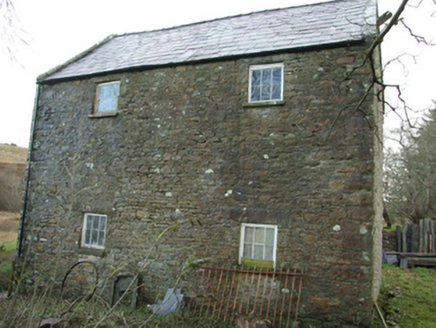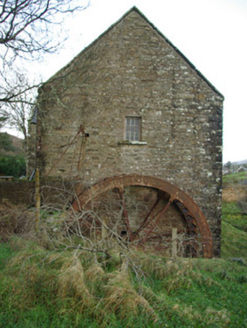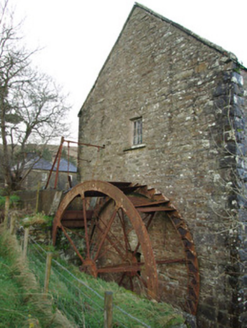Survey Data
Reg No
40844013
Rating
Regional
Categories of Special Interest
Architectural, Technical
Previous Name
Letter Corn Mill
Original Use
Mill (water)
Date
1780 - 1860
Coordinates
163029, 376038
Date Recorded
03/12/2007
Date Updated
--/--/--
Description
Detached four-bay two-storey corn/oat mill on L-shaped plan, built c. 1800 and extended c. 1860, having single-bay two-storey block to the south-west corner. Iron breastshot waterwheel attached to the east gable end of original building. Now disused (since c. 1954). Pitched natural slate roofs purple with raised ashlar verges to gable ends having cut stone kneeler stones at eaves level, and with cast-iron rainwater goods. Rubble stone walls with cast-iron pattrice plates; rock-faced quoins to corners of original building. Square-headed window openings with rock-faced stone lintels, stone sills, and fixed timber windows. Some window openings now blocked. Square-headed door opening to east end of south elevation at first floor level having timber door; opening now boarded. Doorway reached up rubble stone ramp from the south. Square-headed loading bay to the south gable end of extension to the south-west corner having timber sheeted door and remains of metal winch mechanism over to gable apex. Segmental-headed carriage arch to the south elevation of original block having rock-faced stone voussoirs and timber double-doors. Set back from road in own grounds to the east of Cill Chartha/Kilcar; Glenaddragh River adjacent to the north. Former millpond adjacent to the south-east; rubble stone retaining walls and boundary walls to site. Concrete retaining walls to former raised headrace having remains of metal sluice mechanism adjacent to mill wheel. Remains of machinery including mill stones and kiln with furnace to interior. Flagstone floor to interior.
Appraisal
This picturesque small-scale corn/oat mill complex retains its early form and character. It also retains much of its early fabric including natural slate roofs, timber windows and timber sheet doors. The rubble limestone construction and the irregular spacing of the openings give these structures a distinctly vernacular appearance. Of particular interest and importance is the survival of the iron breastshot water wheel and sluice mechanism to the east, which provides an interesting insight in historical industrial methods. This waterwheel was powered using water stored in a large mill pond adjacent to the south-east of the site, which itself was filled with water diverted from the Glenaddragh River along a headrace from the east. Much of the original machinery apparently survives to the interior (not viewed), which is now a rare and important survival. One of the millstones to the interior is inscribed ‘Kay and Hilton, Fleet Street, Liverpool, 1863’ (not viewed). This complex probably originally dates to the late-eighteenth or the early-nineteenth century, a period that saw a great boom in the Irish corn milling industry. The block to the south-west corner is a later addition (post 1837 – Ordnance Survey first edition six-inch map). The modest scale of this complex indicates that it was a vernacular corn mill, rather than a large-scale merchant corn mill as found more commonly in the eastern part of County Donegal. This mill provided a basic service to local farmers in grinding and milling their oats, and was also an important source of employment for the local community. This mill was in the ownership of a John Mullan or McMullan in 1881 and may have been in the ownership of a Robert Hanna in 1894 (all Slater’s Directory), and it apparently remained in use until 1954 (local information). This building is an important element of the built heritage of the Cill Chartha/Kilcar region, and of the industrial archaeology of Donegal.















